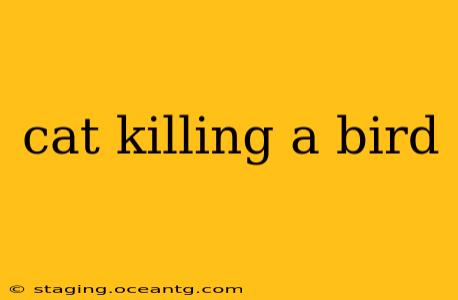Cats, both domestic and feral, are natural predators with a strong hunting instinct. Their pursuit and killing of birds is a deeply ingrained behavior, driven by several factors beyond simple hunger. Understanding this behavior is crucial for responsible pet ownership and for mitigating the impact of cats on bird populations. This article delves into the reasons behind this behavior, exploring common questions and offering insights into this complex interaction between cats and birds.
Why do cats kill birds even when they're not hungry?
This is a frequently asked question, and the answer lies in the inherent predatory drive of cats. Killing isn't solely about sustenance; it's about instinct, play, and territoriality. Cats are equipped with specialized senses and physical attributes – keen eyesight, sharp claws, and silent movements – perfectly adapted for hunting. Even well-fed cats will often engage in the act of hunting and killing, practicing their innate skills. The thrill of the chase and the satisfaction of capturing prey are strong motivators, regardless of hunger.
Are some cat breeds more likely to kill birds than others?
While no breed is inherently more "predatory" than another, certain breeds might exhibit a stronger hunting drive due to selective breeding or inherent characteristics. Breeds developed for hunting, such as Siamese or Abyssinian cats, might show a greater inclination towards hunting activity, including pursuing birds. However, any cat, regardless of breed, can exhibit predatory behavior given the opportunity. Environment and individual personality play a significant role.
How can I prevent my cat from killing birds?
Preventing your cat from hunting birds requires a multifaceted approach focusing on satisfying their natural instincts in safe ways:
- Provide Enrichment: Engage your cat with interactive play sessions using toys that mimic prey. This helps satisfy their hunting drive without harming wildlife. Puzzle feeders can also stimulate their minds and keep them occupied.
- Supervise Outdoor Access: Never let your cat roam freely unsupervised. Harness and leash training can allow controlled outdoor access, minimizing the risk of bird predation.
- Bird-Proof Your Home: Keep windows and doors secured to prevent birds from entering your home, minimizing potential encounters with your cat.
- Training and Deterrents: While not foolproof, training your cat with negative reinforcement (e.g., a loud noise) when they exhibit predatory behavior can help deter them. Some people use motion-activated sprinklers or other deterrents to discourage hunting near windows.
What is the impact of cats on bird populations?
Feral and outdoor cats represent a significant threat to bird populations worldwide. Their predation can contribute to the decline of certain bird species, especially those already vulnerable to habitat loss or other environmental pressures. The cumulative effect of numerous cats hunting in an area can be devastating for local bird communities.
How can I tell if my cat has killed a bird?
Signs that your cat may have killed a bird can include:
- Missing feathers: Your cat might have feathers stuck in its fur.
- Blood or bird parts: Check your cat’s fur, paws, and mouth for traces of blood or bird remains.
- Unusual behavior: Your cat might exhibit unusual excitement or playfulness, indicative of a recent kill.
- A dead bird: Sadly, you might discover a dead bird near your home or brought inside by your cat.
If you suspect your cat has killed a bird, it’s crucial to take preventative measures to reduce the likelihood of future incidents.
Conclusion
Understanding the reasons behind a cat's predatory behavior toward birds is vital for both cat owners and conservationists. By implementing preventative measures and satisfying a cat's natural instincts in safe and responsible ways, we can minimize the impact of domestic cats on bird populations while ensuring the wellbeing of our feline companions. Responsible pet ownership involves acknowledging and addressing these inherent behaviors.
